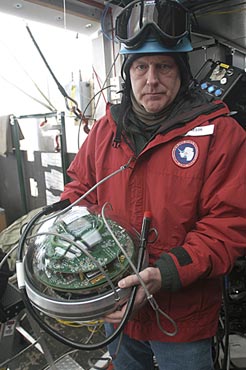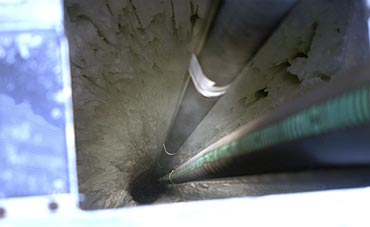
Caption:
Robert Paulos, associate director for the IceCube project, holds one of the digital optical modules that power the IceCube neutrino telescope. The international project, led by UW-Madison physics Professor Francis Halzen, made significant progress this austral summer, adding 480 basketball-sized optical modules used to track signs of cosmic neutrinos. When completed, the neutrino observatory will occupy a cubic kilometer of Antarctic ice, and will be the world's largest scientific instrument.
Image courtesy: courtesy Ice Cube Project
Date: March 2006
200 DPI JPEG version

Caption:
Cables snake down one of the eight 1.5 mile-deep holes drilled this year in the Antarctic ice for project IceCube, a massive neutrino telescope being constructed at the South Pole. The international project, led by UW-Madison physics Professor Francis Halzen, made significant progress this austral summer, adding 480 basketball-sized optical modules used to track signs of cosmic neutrinos. When completed, the neutrino observatory will occupy a cubic kilometer of Antarctic ice, and will be the world's largest scientific instrument.
Image courtesy: courtesy Ice Cube Project
Date: March 2006
200 DPI JPEG version

Caption:
A specialized drill head used to melt snow at the surface of the South Pole is deployed as scientists prepare to drill a 1.5 mile deep hole in the Antarctic ice. Known as the firn drill, the device melts surface snow that has not yet been turned to clear ice in preparation for a novel hot-water drill used to make the deep holes in which long strings of light sensors are deployed. The international project, led by UW-Madison physics Professor Francis Halzen, made significant progress this austral summer, adding 480 basketball-sized optical modules used to track signs of cosmic neutrinos. When completed, the neutrino observatory will occupy a cubic kilometer of Antarctic ice, and will be the world's largest scientific instrument.
Image courtesy: courtesy Ice Cube Project
Date: March 2006
200 DPI JPEG version


